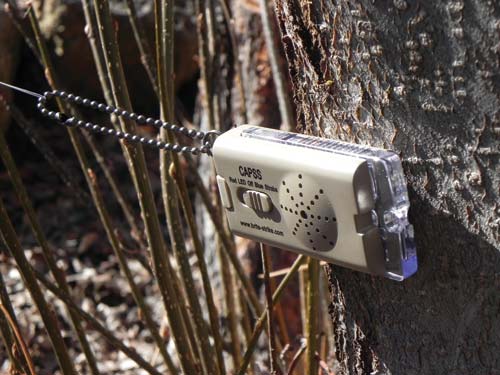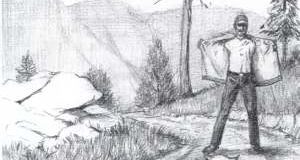| Issue #148 • July/August, 2014 |
It might be a sleeping bag in a lean-to with a small warming fire at the entrance. It could be a wall tent with five or six hunters high in the backcountry. It might be a recreational vehicle parked at the end of a road, a hiker’s bivouac on the shore of an alpine lake, or a place to run to in the event of a natural disaster or unrest in the big city. Whatever the reason for the camp, chances are the camper or campers will have to leave, to hunt, to fish, to hike, to go for supplies. Camp is left unguarded, with no doors or locks nothing between a thief and the potential loot.
After dark, the camp and campers are also vulnerable to the creatures (four-legged and two-legged) that roam the night.
Backcountry camps, both in and outside of established campgrounds, are vulnerable to theft and invasion. Camping equipment is hard to trace to its original owners and is easily converted to cash.
No area of the country is immune. Homelessness and illegal drug use is rampant in the Northwest. Illegal aliens slip across the border all across the Southwest. All over North America, drug lords use backwoods camps for the manufacture of methamphetamines and marijuana grows. When we camp in the country, our nearest neighbors might be a family on their annual fishing trip, or felons on the run.

Build a fire and they will come. Wild animals are fearful of fire, but humans are drawn to it.
Strengths, weaknesses, opportunities, & threats
At home we usually have some sort of early warning system that can alert us to a threat before the threat reaches the threshold of the bedroom. It might be a dog in the yard or the sound of the doorknob opening. In a tent or a shelter, that door is the door of your tent and by then the intruder is inside your personal space.
Examine each campsite with a view to strengths, weaknesses, opportunities, and threats. Is the site defensible? Is cell service available? Where is the closest cell signal connection? What paths lead into and out of camp? Is water close by? What distances must be traveled to find food or go for supplies? Are there wild animals that might make midnight raids on the camp kitchen?
A camp within a day’s walk of a town is likely to have at least a few individuals that make their homes in the woods nearby. How likely would the camp be found by a homeless wanderer or the criminally insane?

To set up the Camp Alert Perimeter Security System, string a trip wire made of fishing line from a fixed object attached to the bead chain pull. When the trip line pulls the pin loose, a high-pitched alarm sounds.
Deterrence
Security is about deterrence. A four-legged predator is likely to stay outside the circle of firelight or a ring of lights. But a two-legged predator may be attracted by illumination. A one-tent camp is more likely to attract thieves than a camp with more than one shelter. The reason? A burglar that chances on an encampment will have to turn his back on one tent to enter the other. One tent may be empty, but the other might be occupied by a camper with a 12-gauge.
For security from theft in recreational camps, pitch your tent near other campers and take the time to introduce yourself to neighbors. Fellow campers tend to watch for each other.
When camped away from others, establish the illusion of more people in camp. One good way to do that is to put out extra chairs around the fire.
Use a decoy tent in such situations. A larger tent might serve as food and gear storage, and another tent nearby, perhaps camouflaged, might be used for sleeping.
Set up camp with a thought to where and how the food will be stored, prepared, and disposed of. Garbage is the main attractant for most predators. A bear can smell bacon grease up to three miles away. It might be spooked off by the human smell and it might not. Coyotes are prone to prowl the perimeter of the camp. If the smell of food is overwhelming, coyotes become a nuisance. Young children are vulnerable to attacks, as evidenced by recent news reports. Raccoons and skunks are even more likely unwanted guests. Neutralize food smells by burying garbage or removing it from camp.
One way to keep a bear out of your food is to protect it. YETI coolers are certified bear-proof by USDA’s Interagency Grizzly Bear Committee. In both controlled bear simulations and wild grizzly encounters, the YETI, with locks in the integrated padlock ports, protects the food inside. And the bear goes looking for protein elsewhere.

A bear can smell bacon grease up to three miles away. A holistic approach to camp security can alert a camper to danger beyond the perimeter.
Distant early warning
One of the best early warning systems is a dog that catches the scent or sound of the intruder. Some dogs are better than others, but the fact is that the camper may not be accompanied by a dog or may not own one. How then can a campsite be secured?
Establish a safety zone in which any prowler might be considered a threat. One hundred yards from the fire might be too far, but a radius of 40 to 60 yards might be appropriate. A perimeter system can be as elaborate as a solar-powered electric fence with a battery backup or as simple as a taut fishing line with empty beer or soda can rattles employed on likely ingress and egress paths.
One 360-degree perimeter system uses a spin-cast fishing reel with six- to ten-pound fishing line. Run the line around camp, then secure the reel in the sleeping area with the drag set low. If the perimeter line is hit by an intruder, the reel will begin to click as the line pulls out.
Another option is a battery-powered motion sensor, but such systems are likely to be tripped by bats, squirrels, and other small varmints and might cause more annoyance than they are worth.
From Brite-Strike Technologies comes the Camp Alert Perimeter Security System (CAPSS), a 135dB audible alarm unit with red lens flashlight and blue flashing LEDs. The CAPSS comes with two rolls of trip wire, two nylon zip ties, eight inches of adhesive mounting tape, and two blue all-purpose adhesive light strips (APALS). Contained in a box the size of a bar of soap, the CAPSS takes up little room in a pack and retails for about $35.
To put the CAPSS to work, identify the expected intrusion path. Attach the alarm module to a fixed object (tree, boulder, parked car, etc.) with the supplied zip ties or adhesive or duct tape. Attach one end of the monofilament trip line to the audible alarm trigger bead chain. Connect the other end of the line to a fixed object on the other side of the intrusion path. When the trip line is tripped, the male post is pulled from the unit and the alarm is triggered 135 earsplitting dB and blue light. An APAL may be used to identify the location of the CAPSS from inside the perimeter.

The components of a small camp security system: a trail cam, a perimeter alert system, an inexpensive LED camp light, an LED flasher, and a handheld light.
Available light
Since most attacks come out of the dark, light can be a deterrent to almost any attacker, whether four-legged or two-legged. In the event of an attack, light up the night with a strobe and an intruder is likely to be disoriented.
The more lumens you put on the subject the better. Lumens is the standard by which light output is judged. LED lights come in a thousand configurations, but for combat, for addressing a threat in low light and ,no-light situations, 100 lumens is the minimum. Better to have 150 or 200 lumens.
Equipment security
If you must leave vehicles or other heavy equipment unattended, there is a simple way to protect them. Harbor Freight sells vibration alarms and door/window alarms for $2 to $4 apiece. When the connection is broken or vibration sets it off, a loud siren is triggered. With on/off switches, they are easily disarmed.
Both alarms are mounted via adhesive tape. Find an unobtrusive spot to mount the device out of the elements. Set the switch on “chime” or “alarm.” Then remember to arm the device before leaving camp.
Signals
Trail cam tips

Here are five simple rules for setting up a scouting camera.
1. Set the frequency of exposures to keep from filling the memory card prematurely.
2. Position the camera at a 45-degree angle to the trail and 24 to 36 inches above the ground, oriented parallel to the grade.
3. Point the camera north. Any other direction and you are likely to have it faced directly into the sun at some point in the day.
4. Clear the area between the lens and the potential target, so that the movement of bushes on a windy day won’t trigger false pictures or cause flashback.
5. Keep a “possibles” kit. Every time you check your trail cam, bring a camera or a viewer, fresh batteries, extra media cards, a lens cloth, and straps in case the squirrels have chewed them through.
If the camp is being used by more than one person that might return from various errands at all hours of the day or night, a set of signals might be agreed upon to include colors of light or number of flashes.
The Energizer LED Safety Flasher (retail $9.75) is a self-contained unit that can be stored in the bottom of a pack and switched on in an emergency situation. With a cyclic rate of 80 flashes per minute, it is an attention getter in an emergency situation or a subtle signaling unit when clicked on for two seconds then clicked off. In a long-term camp, it would be prudent to change the signals from time to time.
The camera eye
Know who and what is watching. Trail camera technology has become so popular that the units are widely available, affordable, and easy to put to work.
Rugged, waterproof, battery-powered and self-operated trail cameras can take photos or record video at any time of night or day. They can be strapped to a tree and left to operate for days or weeks at a time.
Utilizing digital camera technology with motion detection, night vision, and timed recording, the controls are hidden inside a waterproof enclosure. Powered by batteries, the content is written to a removable memory card. Check the card supplied with the unit to determine if there is sufficient memory to record the number of days that the camera will be in use between check intervals. In my cameras, I run cards with 2GB of memory and then set the images at about 3MG resolution.
The cameras are easy to use with switch settings or menu screens. Set the unit to record movies or stills and to the resolution that allows for the optimum memory usage.
At night, some cameras are more useful than others. Most use infrared to see in the dark, which means images will appear in black and white rather than color.
Camera theft is common. One of the main reasons is that the person photographed does not want it to be known that they were in the area. Position the camera in less obvious locations and take care to camouflage it.
Set up a camera on the trail on each side of camp beyond the perimeter, and check the images every couple of days. If someone or something is sniffing around, you will know about it.
Resources
| Brite-Strike CAPSS 11 Raffaele Road Camelot Industrial Park Plymouth, MA 02360 508-746-8701 www.brite-strike.com Coast lights, knives, multi-tools Energizer LED Safety Flasher Bunker Hill Security alarms |
Yeti Coolers 512-394-9384 www.yeticoolers.com Stealth Cam Bushnell HD Torch SOGfari machete |
To order a signed copy of Gary Lewis’ new Hunting Oregon, send $24.95 (includes S&H) to GLO, PO Box 1364, Bend, OR 97709 or visit his website: www.GaryLewisOutdoors.com














